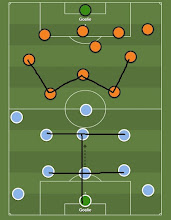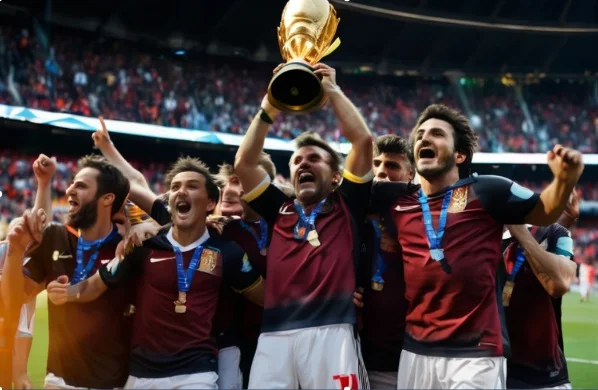A number of football Cinderella stories in the
South and North American top leagues just occurred not so long ago.
2024 marks a new Cinderella story in football
with Bayer Leverkusen’s success in winning their first ever Bundesliga last
weekend. Such similar tales also take place in America, both in the south and
in the north. Here are some incredible stories from unknown teams in the
CONMEBOL and CONCACAF major leagues, which also include Arsenal and Liverpool.
Arsenal de Sarandi (Argentina)
In Argentina, the last Cinderella story occurred
in 2012, when Arsenal de Sarandi (nothing to do with the one from London) won
their first ever league title. At that time, Argentina's top flight utilised
the double-phase competition in its format: Apertura (first half) and Clausura
(second half). Arsenal clinched their title in Clausura. They collected 38
points, two points ahead of Tigre in second place. They took advantage of Boca
Juniors' inconsistent form and River Plate's absence. The latter was still in
the second tier following their relegation in 2011. Arsenal also clinched Supercopa Argentina title in the same year and won the Copa Argentina in the following year.
Gustavo Alfaro, the former Ecuador boss in the
2022 FIFA World Cup, was the man behind their unlikely victory. He is currently
in charge of Costa Rica's Copa America 2024 campaign. A number of players in
his squad would later become well-known, including young Victor Cuesta, who played
for Argentina in the Copa America 2016, young Dario Benedetto, who went on to
become a mainstay at Boca Juniors, and young Guillermo Burdisso, who previously
played for AS Roma and Galatasaray. He currently plays for Huracan.
Atlético Paranaense (Brasil)
In Brazil, such Cinderella stories have not
happened for a while. The last one came in 2001, when Atletico Paranaense won
their first league title. Geninho’s men had to go through a two-legged final to
determine the champions due to sharing the same 63 points as São Caetano. They
crushed their opposition 5-2 on aggregate (4-2; 1-0).
One of their key men, Kleberson, then made a big
move to Manchester United after helping Brazil win their fifth World Cup in
Japan-South Korea in 2002. Other well-recognised names among their fans were
Dagoberto and Donizete.
The club then turned into the new giant outside
the big 12 in Brazilian football. They went on to win more silverware, including
the Copa do Brasil 2019 and two continental titles, the Copa Sudamericana 2018
and 2021.
Liverpool, Montevideo (Uruguay)
This is probably the most recent one in the
region. The Uruguayan Liverpool Montevideo, not affiliated with The Reds,
stunned the fans after snatching the league title in 2023. Under Jorge Bava,
they toppled giant sides such as Penarol and Nacional Montevideo on the table
and thumped Penarol in the championship playoff by 2-1 on aggregate. Bava
guided them to success and snatched the Supercopa title without any well-known
stars in the squad. The former Nacional Montevideo goalie then left the club to
take over the vacant post at Liga MX side Leon in the following season.
CD Cobresal (Chile)
Chile saw a similar tale of wonder in 2015 when
CD Cobresal lifted their first league title in the top division. Under Dario
Giovagnoli, Mineros was at the top of the table with 34 points, or two points
clear of the runner-up, Colo-Colo, and way ahead of other major teams such as
Universidad Catolica and Universidad de Chile. It was their second title in the
club's history. Their first silverware was secured in 1987, when former Inter
and Real Madrid players Ivan Zamorano and Co. helped them win the Copa de
Chile.
Cúcuta Deportivo (Colombia)
Colombia had their own Cinderella story in 2006,
when Cucuta Deportivo won their first ever league title. They lifted the trophy
after defeating Deportes Tolima 2-1 on aggregate in the final stage of the
Colombian top division, Categoria Primera A Finalizacion. The key figure in
their success was the former Costa Rican boss who brought them to the
quarterfinals of the 2014 FIFA World Cup, Jorge Luis Pinto. His team had some
stars at his disposal, such as Panama International, who helped his country
qualify for the 2018 FIFA World Cup; Blas Perez; Macnelly Torres; and Robinson
Zapata.
Club Tijuana (Mexico)
In CONCACAF, Liga MX is undoubtedly one of the
major leagues on the continent. Mexico saw the rise of the unknown side, Club
Tijuana, meddle the domination of the capital clubs and snatch their first
league title in 2012. Antonio Mohammed’s man was able to beat Toluca 4-1 on
aggregate. His team was so underrated that they had no well-known players in
the squad. Unfortunately, Xolos have not won another silverware ever since.
Los Angeles FC (USA)
Last but not least, in the MLS, such a tale just
occurred in 2022 when the LAFC won the MLS Cup, a US top-tier competition.
Steve Cherundolo’s side clinched their first league title after beating the
Philadelphia Union on penalties. Both sides were involved in a thrilling 3-3
draw after 120 minutes. The club, which only joined MLS in 2018, had a
star-studded squad at the time, with the likes of former Arsenal man Carlos
Vela, USMNT midfielder Kellyn Acosta, former Italian international Giorgio
Chiellini, former Barcelona and Real Betis winger Cristian Tello, and the
ex-most expensive player in the world, Gareth Bale. LAFC also won the
Supporters' Shield in the same year for being the best in the regular season.



Comments
Post a Comment